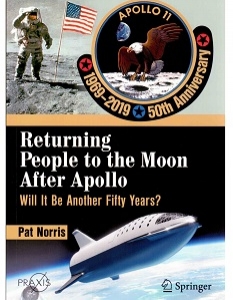It is 50 years since the first men walked on the Moon and 47 years since the last men left the lunar surface to return home. No-one has gone to the Moon since 1972. The subtitle of this book - “Will it be another Fifty Years?”- is a palpable expression of the author’s frustration and, being one of a select band of British engineers to work on the Apollo programme, he is as entitled as anyone.
Reflecting the author’s interest in space history, the first half of the book provides a reminder of why America went to the Moon and how it got there; it also discusses “the other competitor in the race”, the Soviet Union. Although many readers will be familiar with the story, the author’s engineering expertise feeds into the narrative; for example, in explaining the development of the Saturn V, he says “They added baffles into the chamber to damp down the waves of pressure pockets”. It also has a human touch, such as his description of donning the awkward EVA suits: “Aldrin had to talk Armstrong through like a blind man – ‘put your left foot to the right a little bit’ and so on”. And in one of the colour illustrations, he even compares the famous photo of Aldrin on the surface with Holbein’s 16th century portrait of King Henry VIII “in a similar propaganda-style power stance”.
The second half of the book gets down to some analysis of why it is “taking so long to return to the Moon” and the question of “when will the United States go back?”. In answer to the first question, the author concludes that it is at least partly because “the military aren’t interested”, won’t help with funding and might even lobby against it to prevent erosion of their own funding. For the second, the book is sufficiently up-to-date to include discussion of the Lunar Gateway and the plan to return humans to the Moon in 2024. Musk and Bezos are in there too and the author takes a cautiously optimistic stance concerning future prospects.
The book is well written, attractively illustrated and includes a glossary and an index. It would make an ideal primer on manned lunar exploration and would bring the reader ‘up to speed’ on the subject both efficiently and authoritatively.











